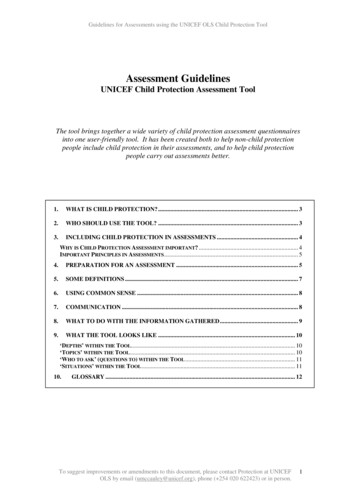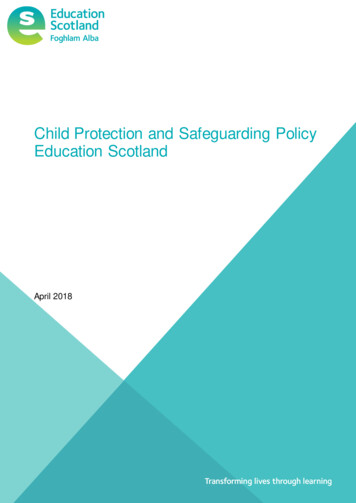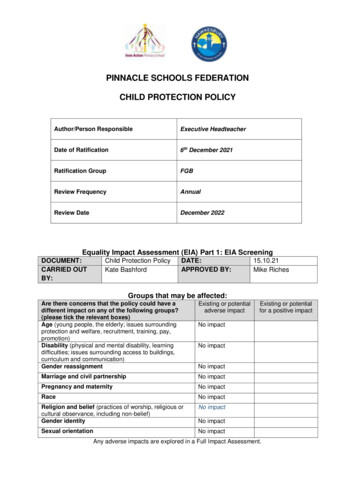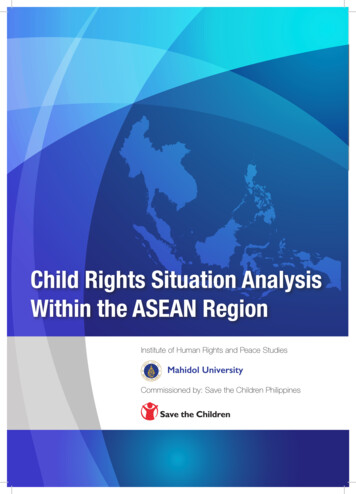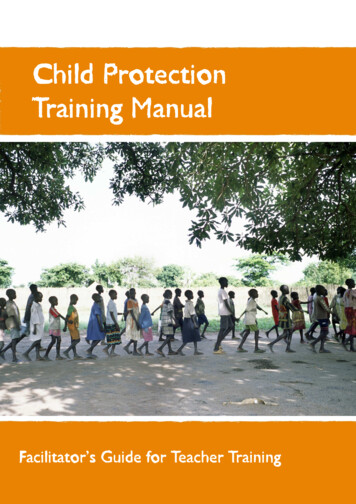
Transcription
SafeguardingStatement of PracticeDocument OwnerDate for ReviewApproved by AABPrincipalJuly 2022December 2021
IntroductionThis document sets out the arrangements for the safeguarding at Bluecoat Trent Academy and operates inconjunction with Archway Learning Trust’s Safeguarding Policy.Related Policies, Statements of Practice and procedures SEN policyPSHE policyAnti-bullying PolicyAttendance and Punctuality Statement of PracticeStatement of PracticeThis procedure reflects current legislation, accepted best practice and complies with the government guidance:Working Together to Safeguard Children April 2018 and Keeping Children Safe in Education 2020.The Designated Safeguarding Lead and the Deputy Designated Safeguarding Leads who are responsible forsafeguarding and child protection at Bluecoat Trent are:NameRoleClaire Ls can also be contacted via the main academy telephone number (0115) 900 7245The named Governor sPhilRowson,contactableviaemail:The Safeguarding Trustee is Richard Vasey, contactable via email:rvasey@archwaytrust.co.ukAcademies should give effect to their duty to safeguard and promote the welfare of their pupils under section175/157 the Education Act 2002 and where appropriate under the Children Act 1989 by: creating and maintaining a safe learning environment for children and young people; and, identifying where there are child welfare concerns and taking action to address them, inpartnership with other organisations where appropriateAPPENDIX 1 - Statutory duties that apply to academies - Working Together to Safeguard Children 2018 &Keeping Children Safe in Education 2020APPENDIX 2 - Reporting concerns to the DSLAPPENDIX 3 - Academy Visitors; ProceduresAPPENDIX 4 - Types of abuse and neglect (KCSIE 2021)APPENDIX 5 – Procedures Flow ChartAPPENDIX 6 - Honour Based Violence Abuse & Forced Marriage Identification and Referral PathwayAPPENDIX 7 – DfE Guidance - ‘Cyber bullying: Advice for Head teachers and school staff’
IntroductionAt Bluecoat Trent Academy the governors and staff fully recognise the contribution the academy makes tosafeguarding children. We recognise that the safety and protection of all pupils is of paramount importance andthat all staff, including volunteers, have a full and active part to play in providing early help protecting pupils fromharm. We believe that the academy should provide a caring, positive, safe and stimulating environment whichpromotes all pupils’ social, physical, emotional and moral development.Ultimately, effective safeguarding of children can only be achieved by putting children at the centre of all that wedo, and by every individual and agency playing their full part, working together to meet the needs of our mostvulnerable children, in line with Working Together 2018 and Keeping Children Safe in Education 2021.The aims of this procedure are to: confirm that the pupils’ development is supported in ways that will foster security, confidence andindependence raise the awareness of teachers, support staff and volunteers of the need to safeguard children and of theirresponsibilities in identifying and reporting possible cases of abuse confirm the structured procedures to be followed by all members of the academy community is cases ofsuspected harm or abuse emphasise the need for good levels of communication between all members of staff and those with designatedresponsibility for child safeguarding, health and safety and other safeguarding responsibilities emphasise the importance of maintaining and implementing appropriate safeguarding policies, procedures andarrangements of those service providers who use the academy’s premises through extended academies orprovide any other before and after academy activities emphasise the links with the academy’s procedure for safe recruitment of staff and volunteers, and formanaging allegations confirm the working relationship with Children and Families Direct and other agencies and, where appropriatewith similar services in neighbouring authorities.Responsibilitiesi.The governing body: has trained link governors for:oSafeguarding and Child Protection – Phil Rowson who will attend training/updates every yearoLooked after Children – Phil Rowson will ensure a member of the governing body is nominated to liaise with the local authority and/or partneragencies on issues of child protection in relation to safeguarding and in the event of allegations of abuse madeagainst the Principal – Kathryn Gardiner (Chair of the Academy Advisory Board). will ensure that the academy has a child safeguarding procedure, single central record, staff behaviourprocedure, operates safe recruitment procedures, makes appropriate checks on staff and volunteers and hasprocedures for dealing with allegations against staff and volunteers. should consider how children may be taught about safeguarding, including online, through teaching andlearning opportunities, as part of providing a broad and balanced curriculum. This may include coveringrelevant issues through PSHE/Citizenship and Relationships and Sex Education (RSE). will ensure that the academy create a culture of safe recruitment and, as part of that, adopt recruitmentprocedures that help deter, reject or identify people who might pose a risk to children (Part three: SaferRecruitment, Keeping Children Safe in Education 2021).
has appointed a member of staff of the academy’s leadership team to the role of Designated SafeguardingLead. will ensure the academy keeps an up to date single central record of pre-employment checks, specifying whenthe check was made and when it will be renewed. monitors the adequacy of resources committed to child safeguarding, and the staff and governor trainingprofile recognises that neither it, nor individual governors, have a role in dealing with individual cases or a right toknow details of cases (except when exercising their disciplinary functions in respect of allegations against staff) will ensure that all staff, Governors and volunteers have undergone appropriate safeguarding training andreceive face to face updates on an annual basis. will make sure that the safeguarding and child protection procedure is available to parents and children onrequest will ensure this procedure and practice complements other policies as detailed above will ensure that key staff are fully supported re. their well beingii. The Principal will ensure that: the policies and procedures adopted by the Governing Body are followed by all staff the procedure will be updated annually, and be available publicly either via the academy website or by othermeans. designated staff review procedure when the NCSCB update their policies and procedures sufficient resources and time are allocated to enable the designated persons and other staff to discharge theirresponsibilities including taking part in strategy discussions and other multi-agency meetings, to contribute tothe assessment and support of children and young people, and be appropriately trained a single central database of all staff, governors, contractors and volunteers, and their safeguarding trainingdates is maintained and that this list confirms that all personnel who meet the specified criteria have had a DBScheck, when this check was made and when it will be renewed all staff and volunteers feel able to raise their concerns about poor and unsafe practice in regard of pupils, andsuch concerns are addressed in a timely manner in accordance with agreed policies. Academy staff are sensitive to signs that may indicate possible safeguarding concerns. This could include, forexample, poor or irregular attendance, persistent lateness, children missing from education, forced marriageor female genital mutilation. undergoes child safeguarding training which is updated regularly, in line with advice from the NCSCP –Nottingham City Safeguarding Children’s Partnership. Guidance for visitors is in place that puts the safeguarding of pupils at the centre and is applied to all visitorsirrespective of their status –see Appendix 3Allegations against the PrincipalWhere an allegation is made against the Principal, the Chair of the AAB must be informed as well as the LADO on0115 9155555 (Claire MacLean)iii. DSL and Deputy DSLsWill: have their role explicitly defined in his roles and responsibilities lead the team of trained Deputy DSLs as detailed above, oversee and quality assure their work
be given sufficient time, funding, supervision and support to fulfil their child welfare and safeguardingresponsibilities effectively. undergo updated child safeguarding training every two years and attend the LA Safeguarding Network meetings liaise with relevant agencies in accordance with the NCSCP procedures when referring a pupil where there areconcerns about possible abuse or harm (Children and Families Direct for a City referral telephone 01158 765600or the Nottinghamshire Multi-Agency Safeguarding Hub (MASH) for a County referral telephone 0300 500 8090). where there are concerns about a member of staff’s suitability to work with children, contact the DesignatedOfficer at Loxley House telephone 01159 155555 Claire MacLean/ Tina Wright/ Eve Hailwood/ Lisa Hurst/Karen Shead.be able to access the contents of the NCSCP procedures and personnel procedures and make these accessibleto all staff ensure all staff, including supply staff, visiting professionals working with pupils in the academy and volunteersare informed of the names and contact details of the designated leads and the academy’s procedures forsafeguarding children support staff who attend strategy meetings, looked after reviews and/or case conferences support staff and volunteers who may find safeguarding issues upsetting or stressful by enabling them to talkthrough their anxieties and to seek further support from the academy leadership group or others as appropriate ensure involvement of other designated leads e.g. where there are concerns about a pupil who is ‘looked after’Ensure that: all staff receive safeguarding and child protection updates (for example via staff bulletins, briefings, CPDsessions and staff meetings) as required but at least annually all child protection records are marked as such and kept securely locked, and if these are stored electronically,that they are differently password protected from the pupils’ other files, and accessible only by thePrincipal/DSLs pupil records are kept separately, and marked as appropriate to indicate other confidential records are beingheld elsewhere CP records are transferred securely and a receipt obtained from the receiving academy any absence letters are dated and clearly signed by a teacher/tutor, and that if: there are concerns aboutattendance and a pupil’s wellbeing and safety, the appropriate safeguarding authority is alerted phone calls about absences are similarly logged and dated the children missing education- statutory guidance for local authorities 2016 is adhered to. Please seeAttendance Procedure for the academy’s approach to tackling CME where a pupil is subject to a Child Protection Plan, and is absent without explanation for two days, their keyworker in Children’s Social Care is contacted. records are monitored for patterns of what when taking in isolation would appear to be low level concerns andappropriate action is taken where there are existing concerns about a pupil, and they transfer to another academy in this authority, a copyof information held e.g. a CAF is forwarded under confidential cover and separate from the pupil’s main file tothe DSL in the receiving academy. where a pupil has a child protection plan or there are ongoing child protection enquiries and transfers toanother academy;othe DSL is informed immediately
otheir child protection file is copied for any new academy or college as soon as possible but transferredseparately from the main pupil file.iv. The staffAll staff, teaching and non-teaching, volunteers and others working in academy need to: report any concerns about the conduct of other adults in the academy to the Principal without delay (or wherethat is not possible to the DSL) be fully aware of the academy’s procedure and sign each year to say that they have read it, alongside Part 1 ofthe KCSIE 2021 and also “What to do if you re worried that at child is being abused: advice for practitionersguidance.” (2015) 3.8.1 in the Staff Handbook be aware that to safeguard children, they have a duty to share information with the designated leads, andthrough the DSL, with other agencies be aware that despite the requirement to share information with DSLs they can make their own referral tochildren’s Social Care, e.g. in urgent situations. be alert to signs and symptoms of harm and abuse know how to respond to their duty when they have concerns or when a pupil discloses to them know how to record concerns and what additional information may be required. undergo child safeguarding training which is updated regularly in line with advice from the NCSCB, plus regularupdates as required via staff bulletins, briefing, CPD and staff meetings at least annually) maintain an attitude of ‘it could happen here’ and to help develop ‘a culture of vigilance’WhistleblowingWhere there are concerns about the way that safeguarding is carried out in the academy, staff should refer tothe Whistle-blowing Procedure.A whistleblowing disclosure must be about something that affects the general public such as: a criminal offence has been committed, is being committed or is likely to be committed an legal obligation has been breached there has been a miscarriage of justice the health or safety of any individual has been endangered the environment has been damaged Information about any of the above has been concealed.The NSPCC runs a whistleblowing helpline on behalf of the Home Office, the number is 0808 800 5000Managing Allegations against other pupilsIf a disclosure made to a member of staff indicates that there is a case of pupil to pupil abuse, this should bereported immediately to the DSL who will follow the academy’s safeguarding procedures as necessary.Mobile Phone and Camera UseAt Bluecoat Trent Academy we have a separate procedure in respect of Mobile Phone and Camera use in the ITAcceptable Use Agreement for pupils and parents. Staff have been instructed to only use academy devices ifphotographing or filming pupils.
Prevention in the Curriculum The academy recognises the importance of developing pupils’ awareness of behaviour that is unacceptabletowards them and others, and how they can help keep themselves and others safe. The RSHE programme in each key stage provides personal development opportunities for pupils to learn aboutkeeping safe and who to ask for help if their safety is threatened. As part of developing a healthy, safer lifestyle,pupils are taught to, for example:osafely explore their own and others’ attitudesorecognise and manage risks in different situations and how to behave responsiblyojudge what kind of physical contact is acceptable and unacceptableorecognise when pressure from others (including people they know) threatens their:opersonal safety and well-being and develop effective ways of resisting pressure;oincluding knowing when and where to get helpoInternet SafetyFurther Supporting Information:Personal RelationshipsUnder no circumstance is it acceptable for a member of staff to form a relationship with a pupil attending BluecoatTrent Academy. This applies to all pupils, including those who are aged 16 and over; the age of the pupil is irrelevantbecause any relationship would be a breach of the Position of Trust bestowed upon all staff who work at theAcademy.One to one workStaff involved in working with pupils on a one to one basis should ensure that they are visible whenever possible.This means using an open plan room or working in a room with the door open or a window in the door. Both partiesshould be comfortable with the arrangement for one to one work and parents should be aware that this is part ofthe provision at academy. Under no circumstances should a pupil be allowed to enter the staff room or a staff workroom. This will be regularly monitored by the DSL.Offering a lift to a pupilTransport arrangements should be made in advance by a designated member of staff. Wherever possible andpracticable transport should be provided other than in private vehicles, with at least one adult additional to thedriver acting as an escort. It should not be necessary, other than in exceptional circumstances, where all otheroptions have been exhausted, to give a lift to a young person. If this is the last option, the member of staff mustliaise with a member of SLT prior to offering a lift and must then be accompanied by a colleague with the youngperson seated in the back of the car. Parents of the young person must know about this arrangement and be inagreement with it.Email/Mobile Telephone numbersUnder no circumstance should staff give out personal email addresses or mobile telephone numbers to pupils atthe academy. There are academy mobiles telephones available for staff to use on academy trips, the numbers ofwhich can be given to pupils for emergency purposes.Protecting personal informationDevelopments in recent years with regards to the use of Social Networking Sites have necessitated clear guidanceto staff. The DFE has published a guide entitled ‘Cyber bullying: Advice for Headteachers and school staff’ which isa useful point of reference if further guidance is needed. See Appendix 7.
Power and positions of trustAll adults working with children and young people are considered to be in a position of trust, as a consequence oftheir knowledge, position and/or the authority invested in their role, and this equally applies to adults who act in avoluntary capacity.This means that adults should: ensure that an unequal balance of power is not used for personal advantage or gratification; maintain appropriate professional boundaries and avoid behaviour which might be misinterpreted by others;and report and record any incident where their behaviour may be misinterpreted with a senior manager at theearliest opportunity.This means that adults should not: use their position to gain access to information for their own or others’ advantage; use their position to intimidate, bully, humiliate, threaten, coerce or undermine children or young people; or use their status and standing to form or promote relationships which are of a sexual nature, or which maybecome so.Propriety and BehaviourAll adults have a responsibility to maintain public confidence in their ability to safeguard the welfare and bestinterests of children and young people with whom they work or come into contact with. It is therefore expectedthat they will adopt high standards of personal conduct in order to maintain the confidence and respect of thepublic in general and all those with whom they work.There may be times, for example, when an adult’s behaviour or actions in their personal life come under scrutinyfrom local communities, the media or public authorities. This could be because their behaviour is considered tocompromise their position in their workplace or indicate an unsuitability to work with children or young people.Misuse of drugs, alcohol or acts of violence would be examples of such behaviour. The behaviour of an adult’spartner/spouse or of other family members may raise similar concerns and require careful consideration by anemployer as to whether there may be a potential risk to children and young people in the workplace.Adults in contact with children should therefore understand and be aware that safe practice also involves usingjudgement and integrity about behaviours in places other than the work setting.This means that adults should: follow any codes of conduct deemed appropriate by Archway Learning Trust and/or their professional body; understand that the behaviour and actions of their partner (or other family members) may raise questionsabout their suitability to work with children and young people.This means that adults should not: behave in a manner which would lead any reasonable person to question their suitability to work withchildren or act as a role model; or make, or encourage others to make, unprofessional personal comments which scapegoat, demean orhumiliate, or which might be interpreted as such.
Physical ContactMany jobs within the children’s workforce require physical contact (including personal care) with children as a partof their role; however, it is crucial that adults only touch children in ways which are appropriate to their professionalor agreed role and responsibilities. Not all children and young people feel comfortable about physical contact andadults should not make the assumption that it is acceptable practice to use touch as a means of communication.This means that adults should: be familiar with and follow any recommended guidance and protocols; treat children with dignity and respect always explain to a child the reason why contact is necessary and what form that contact will take (especiallyimportant when physical intervention to manage a child’s behaviour is required); be aware that even well intentioned physical contact may be misconstrued by the child, an observer or byanyone to whom this action is described; never touch a child in a way that may be considered to be indecent; always be prepared to report and explain actions and accept that all physical contact is open to scrutiny; not indulge in horseplay; work within Health and Safety regulations; be aware of cultural or religious views about touching and always be sensitive to issues of gender; and understand that physical contact in some circumstances can be easily misinterpreted.What about other physical contact with pupils?The most recent guidance (January 2016) about use of reasonable force (contained within the January 2016 DfEguidance: ‘Behaviour and Discipline in Schools’) states that ‘Members of staff have the power to use reasonableforce to prevent pupils committing an offence, injuring themselves or others, or damaging property, and tomaintain good order and discipline in the classroom’. It is not illegal to touch a pupil. There are occasions whenphysical contact, other than reasonable force, with a pupil is proper and necessary.Examples of where touching a pupil might be proper or necessary: When comforting a distressed pupil; When a pupil is being congratulated or praised; To demonstrate how to use a musical instrument; To demonstrate exercises or techniques during PE lessons or sports coaching; and To give first aid.It is recognised that some children who have experienced abuse may seek inappropriate physical contact and adultsshould be particularly aware of this when it is known that a child has suffered previous abuse or neglect. In thechild’s view physical contact might be associated with such experiences and lead to actions being misinterpreted.Where a child seeks or initiates inappropriate physical contact with an adult, the situation should be handledsensitively and care taken to ensure that contact is not exploited in any way. Careful consideration should be givento the needs of the child, and the member of staff must email the DSL and DDSLs via the Honeycomb.All children have the right to be treated with respect and dignity even in those circumstances where they displaydifficult or challenging behaviour. Adults should not use any form of degrading treatment to punish a child. It is notacceptable under any circumstance to use sarcastic, demeaning or insensitive comments towards children andyoung people or to use corporal punishment.
This means adults should: not use force as a form of punishment; try to defuse situations before they escalate; inform parents of any behaviour management techniques used with their child at the earliest opportunity; adhere to the behaviour management procedure in place within the educational setting, and be mindful offactors that may impact upon a child or young person’s behaviour, such as bullying or abuse, and takeappropriate action where necessary.This means that childcare, academies and education settings should have in place appropriate behaviourmanagement policies, and where appropriate, have the capacity to develop positive handling plans in respect of anindividual child or young person, in consultation with the child’s parents or carers. At Bluecoat Trent Academy theseare created and managed by the SENCO, Caron Cox.Physical InterventionThere are circumstances in which adults working with children displaying extreme behaviours can legitimatelyintervene by using physical intervention techniques. This refers to the ‘positive intervention’ techniques andtraining undertaken by staff working in Behaviour Support.The use of physical intervention must be avoided wherever possible. It should only be used if it is necessary toprevent personal injury to the child, other children or an adult, to prevent serious damage to property or in whatwould reasonably regarded as exceptional circumstances. The scale and nature of any physical intervention mustbe proportionate to both the behaviour of the individual to be controlled and the nature of any harm that they maycause. The minimum force necessary should be used and the techniques deployed must be in line withrecommended procedure and practice.Staff must be aware that the use of unwarranted physical force is likely to constitute a criminal offence. In all caseswhere physical intervention is employed, the incident and subsequent actions should be documented and reportedto senior staff. The parents/carers should be informed by senior staff on the same day that the incident took place.Vulnerable GroupsSome children and young people may be particularly vulnerable to abuse and harm. The DSLs should be aware ofthe range of guidance that is available and vigilant to concerns being raised by staff and children which need to bereported in accordance with national (Government) and local procedures without delay. DSLs should also ensurethat staff working with children are alert to signs which may indicate possible abuse or harm.Child Sexual Exploitation (CSE) and Child Criminal Exploitation (CCE)Both CSE and CCE are forms of abuse and both occur where an individual or group takes advantage of an imbalancein power to coerce, manipulate or deceive a child into sexual or criminal activity. Whilst age may be the mostobvious, this power imbalance can also be due to a range of other factors including gender, sexual identity, cognitiveability, physical strength, status, and access to economic or other resources. In some cases, the abuse will be inexchange for something the victim needs or wants and/or will be to the financial benefit or other advantage (suchas increased status) of the perpetrator or facilitator. The abuse can be perpetrated by individuals or groups, malesor females, and children or adults. The abuse can be a one-off occurrence or a series of incidents over time, andrange from opportunistic to complex organised abuse. It can involve force and/or enticement-based methods ofcompliance and may, or may not, be accompanied by violence or threats of violence. Victims can be exploited even
when activity appears consensual and it should be noted exploitation as well as being physical can be facilitatedand/or take place online.Who is at risk?It can happen to any young person from any background. Although the research suggests that the females are morevulnerable to CSE, boys and young men are also victims of this type of abuse. CCE can happen to anyone. Thecharacteristics common to all victims are not those of age, ethnicity or gender, rather their powerlessness andvulnerability. Victims often do not recognise that they are being exploited because they will have been groomed bytheir abuser(s). As a result, victims do not make informed choices to enter into, or remain involved in, exploitativesituations but do so from coercion, enticement, manipulation or fear. CSE & CCE exploitation can happen face toface and it can happen online. It can also occur between young people. In all its forms, both are child abuse andshould be treated as a child safeguarding issue.The academy adheres to the following: UKCCIS Guidance; Sexting in academies and colleges, responding toincidents and safeguarding young people (2016) and the DfE Guidance: Child Sexual Exploitation - Definition and aguide for practitioners, local leaders and decision makers working to protect children from child sexual exploitation,February 2017.Referrals are made to:Racheal OsborneCSE Coordinator & Missing Children’s Team ManagerDirect Line: 0115 8761203Mobile: 07432721240Email: racheal.osborne@nottinghamcity.gov.ukSecure Email: racheal.osborne@nottinghamcity.gcsx.gov.ukFemale Genital MutilationFemale genital mutilation refers to procedures that intentionally alter or cause injury to the female genitalorgans for non-medical reasons. The practice is illegal in the UK. FGM typically takes place between birth andaround 15 years old; however, it is believed that the majority of cases happen between the ages of 5 and 8.Risk factors for FGM include: low level of integration into UK societymother or a sister who has undergone FGMgirls who are withdrawn from PSHEvisiting female elder from the country of originbeing taken on a long holiday to the country of origintalk about a ‘special’ procedure to become a womanFGM may be likely if there is talk of a special procedure or celebration to become a woman, or parents wish totake their daughter out-of-academy to visit an ‘at-risk’ country (especially before the summer holidays), orparents who wish to withdraw their children from learning about FGM.Indications that FGM may have already taken place may include: difficulty walking, sitting or standing and
At Bluecoat Trent Academy the governors and staff fully recognise the contribution the academy makes to safeguarding children. We recognise that the safety and protection of all pupils is of paramount importance and . confirm that the pupils' development is supported in ways that will foster security, confidence and independence

